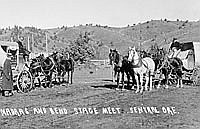Settlement
John Newton Williamson, Crook County stockman, attorney, and U.S. congressman, provided the following sentiments for An Illustrated History of Central Oregon in 1898: “Crook County has withstood the recent hard times as well as any community on the Pacific Coast...this statement of facts simply proves the assertion that...a stock raising country is the best country on earth for a poor man.”
Indeed, central Oregon was a stock raising country, and the lure of open range and free grazing attracted many of the first settlers. The quality of the grazing that they found apparently varied considerably. Peter Skene Ogden remarked in 1826 that the soil on the Crooked River was “remarkably rich, and in some parts the grass seven feet high.” John Charles Frémont, on the other hand, was not impressed enough to mention the potential of any part of the area. The lost Meek party drove 2,299 loose cattle, 811 oxen, and 1,512 goats through central Oregon in 1845. At least one immigrant, William Goulder, did not like it at all: “The new route was trackless waste, covered...by immense fields of sage brush that grew tall, strong and dense. Through these sage fields we were obliged to force the oxen, the teams taking turns in breaking their way through the sage.”
Captain H.D. Wallen led a military reconnaissance into central Oregon in 1859, reporting that it contained “grazing country sufficient for numberless flocks and herds.” Five years later, Captain John Drake, leading another army reconnaissance, formed a different impression: “As for the country, I have no desire to visit it or any portion of it again. It is a desert to all intents and purposes, utterly worthless, sandy, rough and rugged...with a stunted growth of juniper covering the surface.”
In the late 1860s, stockmen from the Willamette Valley began moving eastwards across the Cascades to find seasonal grazing on the central Oregon bunchgrass. They typically drove their stock across the Cascades in the spring and grazed their stock until the first winter snowstorms threatened to block the passes. They were not interested in remaining in central Oregon during the winter months, but if they did contemplate settlement, they chose the creek bottoms on the western flanks of the Blue Mountains and the Crooked River Basin. Trout Creek, Willow Creek, Hay Creek, Ochoco Creek, Mill Creek, Camp Creek, and others began to fill with isolated homesteads. The 1870 census of the Ochoco District reported 160 inhabitants. Fifty-two raised livestock, twenty-five kept house, two cut lumber, and one worked as a blacksmith.
The Robbins family was one of the earliest families to settle in the Ochoco country. Kate Robbins wrote lively letters to her family back in Massachusetts. For example, in January 1871, she noted that “All the hills and little valleys are covered with rich grass which fattens very rapidly, and of course the cows give lots of milk.” This Eden for livestock also had a liberating effect on the stockmen. George Barnes, another early settler, described one of his neighbors: “He did not care if he was ragged and dirty.... He shaved once a week with a butcher knife and he was always ready to back his ‘mar’ against any horse in the country for 15 buck hides.”
Wagering with deer skins points to an important aspect of early ranching. There was little money available because there was no easy way to turn the livestock into cash. Ranchers had to drive their steers to the nearest market, which usually required weeks of travel. Abner Robbins planned to drive “75 head of beef and 25 or 30 horses” to the mines in Idaho in the summer of 1871. Another settler from the 1870s, Cortley Allen, summarized his experiences in an interview for the Bend Bulletin in 1922: “People think that we first settlers should all be rich. Our trouble was lack of transportation. I have sold cattle to be driven to Cheyenne, and others to be driven to California. Men with capital would buy calves at $2.50 a head, and let them out to us on shares. We gave them half the selling price, and that way we could get a start. Some years we would make money, and other years...we would be cleaned out again.”
Small ranchers like Cortley Allen or the Robbins family did not always cut hay for wintering their stock. They trusted to luck that the snow would not be too deep for the cattle to dig down to edible grass. Additionally, there were warm winds called Chinooks that usually followed a heavy snowfall. The Dalles Mountaineer published this humorous poem in 1872: “Oh stockman’s God! O thou To whom we always look And humbly, trusting bow In prayer and praise - CHINOOK! On thee we more rely Than all the hay and straw, Or barley, oats, or rye For thy propitious thaw. O grant thy winds and rains Upon us poor to send, And we’ll not pray again Until next fall, Amen.”
© Ward Tonsfeldt and Paul G. Claeyssens, 2004. Updated and revised by OHP staff, 2014
Sections
Related Historical Records
Peter Skene Ogden (c. 1790-1854)
Peter Skene Ogden was a key figure in the land-based fur trade of the Pacific Northwest and British Columbia during the first half of the nineteenth century. This photograph …

John Charles Fremont
John C. Frémont, pictured here as a Union Major General, was born in Savannah, Georgia on January 21, 1813. He briefly taught mathematics to U.S. naval cadets before …





